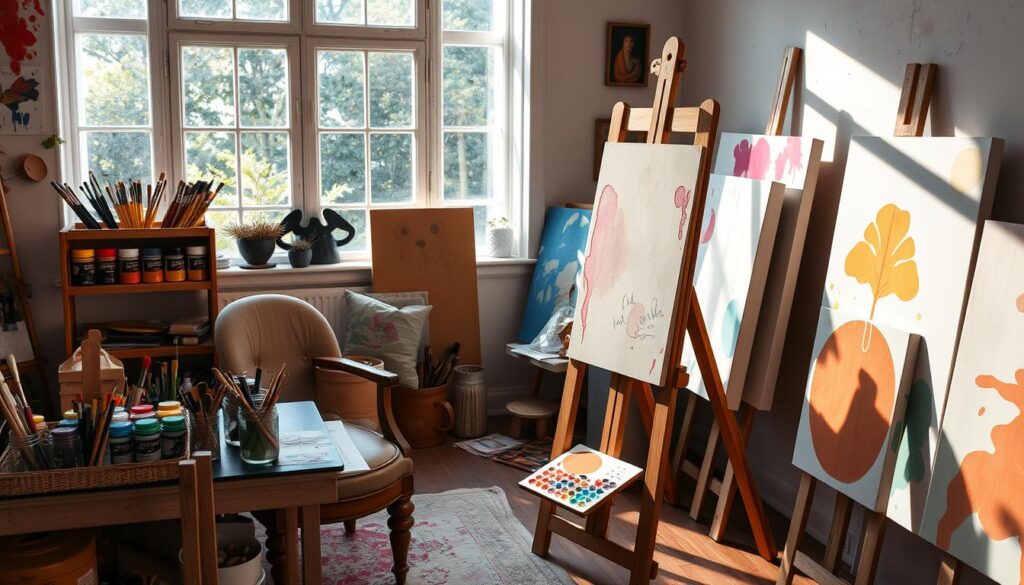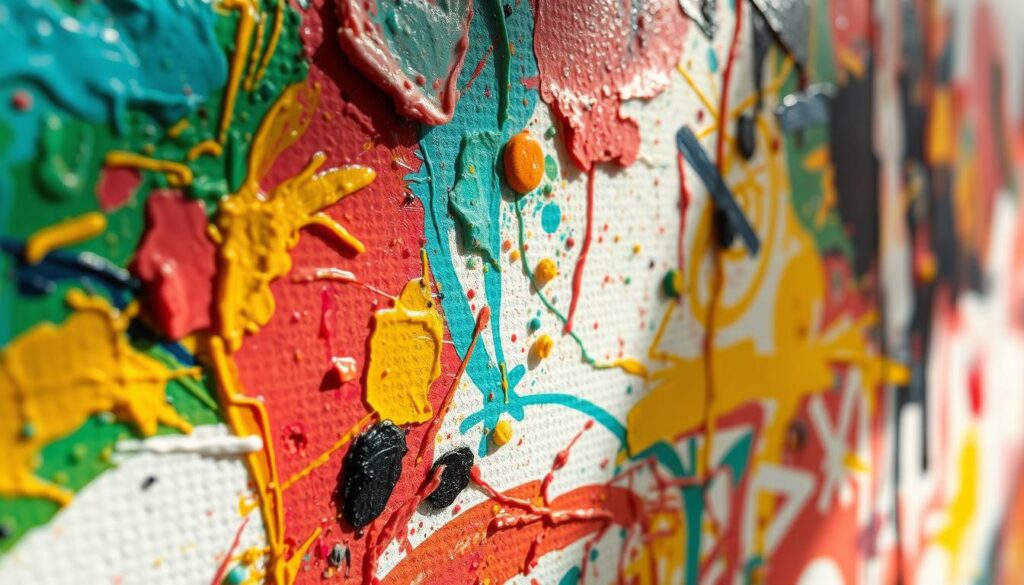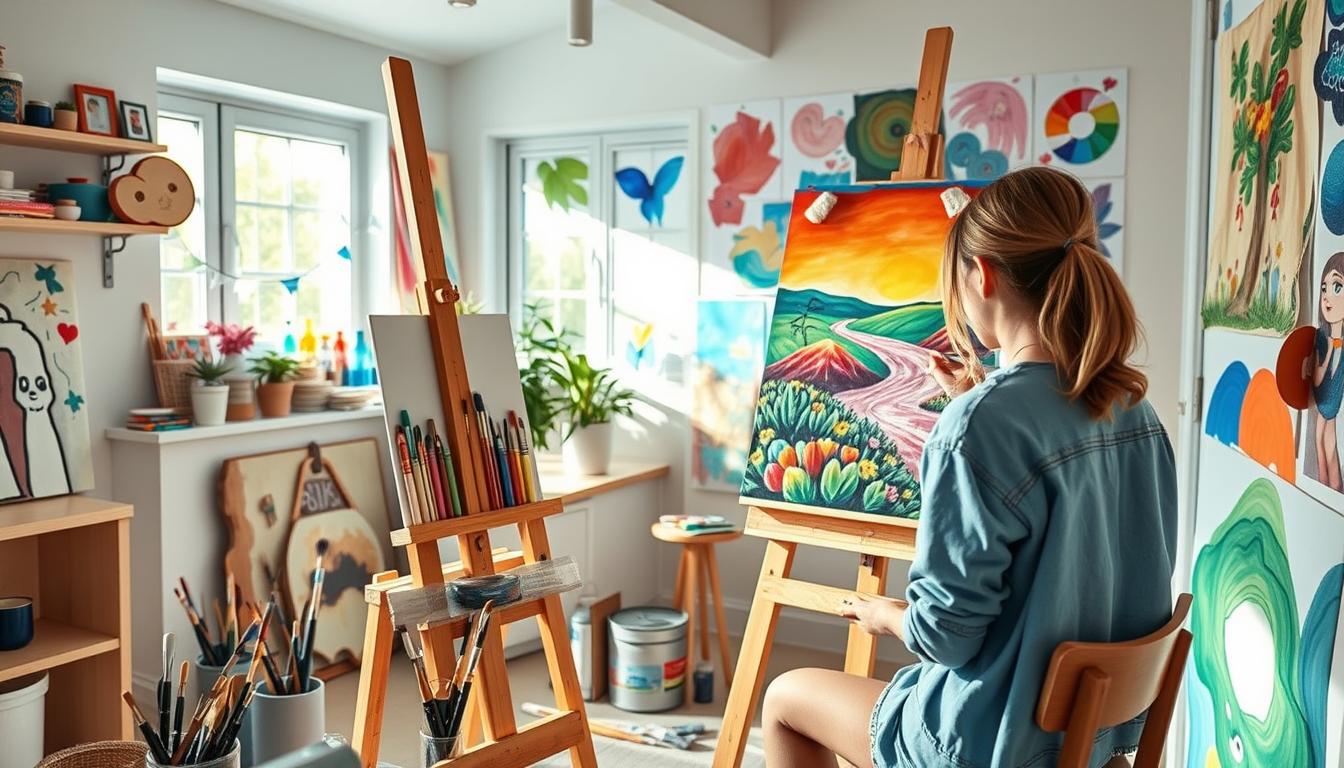This post contains affiliate links.
Have you ever wondered why acrylic painting is so popular with beginners?
Acrylic painting is a great way to start your art journey. It’s versatile and easy on the wallet. This paint dries fast, which is great for adding layers and textures to your art.
Starting with acrylic paint can spark your creativity. You can paint alone or with friends. There are many resources available, like step-by-step tutorials for beginners. These tutorials help you learn how to blend colors, layer, and add textures.
Learning the basics of acrylic painting can lead to amazing art. It’s all about practicing, exploring, and finding your style. Our guide will give you the tips and techniques you need to start. With time and effort, acrylic art can be your canvas.
Key Takeaways
- Acrylic painting is a versatile and affordable medium perfect for beginners.
- Acrylic paint dries quickly, allowing for easy layering and texturing.
- Numerous tutorials are available to help beginners quickly learn essential techniques.
- Essential supplies, including various brushes and acrylic paints, are necessary for a successful start.
- Consistent practice and experimentation are key to mastering acrylic painting.
- Acrylics are suitable for a variety of surfaces, enhancing their versatility.
Introduction to Acrylic Painting
Acrylic painting is a fun journey for both new and experienced artists. For those starting, it’s key to know the basics of acrylic paint. This paint can go on many surfaces like canvas, paper, and even glass. Its versatility makes it great for beginners who want to try new things.
Understanding Acrylic Paint
Acrylic paint dries fast and is easy to clean up. This is great for beginners who don’t want to wait long between layers. It also doesn’t have strong smells, making it safe to use indoors.
Acrylics can mix with other materials like pastels or watercolors, opening up more creative possibilities. For deeper learning, checking out acrylic painting techniques can help you learn new effects and textures.
Why Choose Acrylic Paint
Acrylic paint is great for experimenting without spending a lot of money. It comes in many affordable options. You can apply thin or thick layers, depending on how fast or slow you want them to dry.
It’s also easy to use, perfect for beginners. You can try different techniques like brush strokes or thick, textured paint. Tutorials will show you how to be creative with acrylics. Brands like Winsor & Newton and Liquitex offer quality paints for all levels.
Acrylic paint is flexible for any project, big or small. It’s perfect for those starting out or experienced artists. It supports your artistic vision with ease.
Essential Supplies for Acrylic Painting
Starting with acrylic painting means getting the right supplies. There are many tools and materials out there, but knowing the basics is crucial for great art. Let’s look at the main supplies you’ll need to begin your acrylic painting journey.
Types of Acrylic Paints
Choosing the right acrylic paint is key for artists. There are two main types: Student Quality and Artist Quality. Student Quality is more affordable but has more filler and less pigment. Brands like Golden Heavy Body, Liquitex Heavy Body, and Winsor & Newton offer Artist Quality paints with better coverage and color.
For beginners, start with basic colors like white, black, primary colors, and earth tones. This gives you a good base. Artist Quality paints last longer and make your art look vibrant and lasting. For more details, check out this step-by-step guide.
Brushes and Their Uses
Choosing the right brushes is as important as picking the paint. Synthetic brushes are a good choice because they’re affordable and kind to animals. You’ll need different brush sizes—big, medium, and small.
Soft brushes help with smooth strokes, while firm ones work well with heavy paints. Short-handled brushes are great for stability and accuracy. Chisel blenders are perfect for details and acrylic paint blending. Having a set of brushes lets you try out different shapes and techniques.
Other Necessary Tools and Materials
There are more tools and materials that make acrylic painting better. Here are some essentials:
- Surfaces: You can use stretched canvas, canvas boards, canvas paper, or wood panels, depending on your project.
- Mixing Palettes: These are vital for mixing colors and creating smooth transitions.
- Water Cups and Rags: Use these to clean your brushes and keep your workspace clean.
- Additional Supplies: Don’t forget painter’s tape for straight lines, palettes or plates for mixing, and aprons to protect your clothes.
Having a full set of art supplies for acrylics lets us fully explore and express our creativity. You can find these supplies at stores like Michael’s, Blick Art Materials, Hobby Lobby, or online at Amazon. High-quality materials from Liquitex will give you a top-notch artistic experience.
With the right acrylic paint, brushes, and other painting tools, we’re ready to start our creative journey. We can make lasting and colorful artworks.
Setting Up Your Workspace
Creating a welcoming and efficient art studio is key to doing your best work. Start by picking a spot with lots of natural light. Good lighting is important for seeing colors right and for your eyes during long painting sessions. Artists often work up to 40 hours a week.
Organizing your supplies makes creating easier. Keep your paints, like top-quality acrylics, within reach. Begin with three to five colors for mixing. Use a glass or disposable palette for easy cleanup. Don’t forget essential tools like flat brushes, used 90% of the time for their versatility.

Protect your space with drop cloths or newspapers to catch spills. Keep a water container on your dominant side, but away from your work. Wear protective clothes to avoid paint stains.
Good airflow is key for a great acrylic painting space. It helps paints dry faster and keeps the air clean. Ventilation also keeps you safe from paint fumes, especially when using a glossy varnish to protect your art.
Joining art communities online or in person can spark inspiration and support. Setting SMART goals helps track progress and improve skills. Planning your work by sketching first ensures a better composition.
A well-organized art studio boosts creativity and supports your acrylic painting skills. By adding these elements to your space, you’re setting up for success in art.
| Element | Details |
|---|---|
| Lighting | Ample natural light or high-quality artificial lighting |
| Organization | Accessible arrangement of paints and tools |
| Protection | Drop cloths, newspapers, and protective clothing |
| Ventilation | Enhanced airflow to aid paint drying and air quality |
| Tools | Flat brushes, glass or disposable palette, water container |
Basic Acrylic Painting Techniques
Starting with acrylic painting means learning key techniques to improve your art. Knowing how to mix paint, layer, and blend colors is crucial. These skills will quickly take you from a beginner to a pro. Let’s dive into some important methods.
Blending Paint
Smooth color transitions are key in many paintings. Blending acrylic colors means mixing them together smoothly. You can do this by layering wet paint on wet layers or using dry brushing for texture.
Layering Paint
Layering is key for depth and detail in your art. Let each layer dry before adding more to build up textures and details. This method is great for underpaintings and highlights in dark areas.
Mixing Colors
Mixing acrylic paint is vital for the right colors in your work. A color mixing chart can be very helpful. It keeps track of color combinations and lets you try out different shades. Blending colors before canvas use also prevents unwanted dullness.
Using these basic techniques makes acrylic painting fun and fulfilling. Every brushstroke and layer adds depth to your art, turning it into a masterpiece.
| Technique | Method | Tip |
|---|---|---|
| Blending Paint | Wet-on-wet | Use a wet brush for smooth transitions |
| Layering Paint | Wet-on-dry | Allow layers to dry completely before adding more |
| Mixing Colors | Palette mixing | Create a color chart for reference |
Creating Textures with Acrylics
Acrylic painting lets us take our art from just looking good to feeling good too. We can make any canvas feel like a sensory wonderland. By using different tools and techniques, we can create rich textures in our paintings.

Techniques for Adding Texture
First, we layer and embed materials into wet acrylic paint. Heavy-body acrylics are great for this, giving us a solid base. Then, we use pouring, splattering, and lifting paint to get unique textures.
Techniques like dripping paint can look like rain or melting objects. Lifting paint can make our art look like fabric or clouds. These methods let us be super creative.
Using Mediums for Texture
Acrylic mediums are key for adding depth to our art. Gel mediums are perfect for thick textures, making our paint pop. Modeling pastes let us sculpt and add textures that mimic real materials.
With mediums like blended fibers, we can get pulp-like effects. Glass beads give a semi-gloss, bubbly look. Trying out these mediums helps us create dramatic textures and connect more with our art.
Experimenting with Tools
Using different tools is a fun way to make textures. Palette knives, trowels, and ridged knives help us create bold textures. Splatter brushes are great for a lively, spontaneous look.
Adding colors like metallic and fluorescent to our textures makes them stand out. Mixing in fabrics, lace, and buttons adds more details and texture to our art.
Textured painting makes our art more than just something to look at. It turns paintings into a world we can touch and feel, pulling us and others into the artwork.
Advanced Acrylic Painting Techniques
Exploring advanced acrylic painting techniques can open up new creative possibilities in your art. These methods add depth, texture, and fine details to your work. Let’s look at three key techniques: glazing, impasto, and sgraffito.
Glazing
Glazing means putting thin, clear layers of paint over a base layer that’s already dry. This lets light go through and bounce off the colors underneath, making them glow. It’s great for creating bright colors and a shining effect in portraits. Learning glazing techniques can make your paintings look more sophisticated. For more info, check out free online tutorials on glazing.
Impasto
Impasto is about using thick, textured paint layers with brushes or palette knives. It makes the paint pop off the canvas, giving your art a touchable quality. This method is perfect for artists who want to add a three-dimensional feel to their work.
Sgraffito
Sgraffito is a technique where you scratch through wet paint to show off the layer underneath. It’s great for adding fine details and textures. Often used in portraits, sgraffito can highlight complex patterns and contrasts, making your artwork richer. This method takes practice but can be very rewarding.
| Technique | Description | Tools Required |
|---|---|---|
| Glazing | Applying thin, translucent layers of paint for a luminous effect. | Soft brushes, acrylic mediums |
| Impasto | Building up thick layers of paint for added texture. | Palette knives, stiff brushes |
| Sgraffito | Scratching through wet paint to reveal layers beneath. | Pointed tools, palette knives |
Using these advanced acrylic painting techniques can bring depth, texture, and expression to your art. Whether you’re going for a glowing effect with glazing, adding texture with impasto, or revealing layers with sgraffito, each method opens up new creative paths. So, dive in and take your art to the next level!
Understanding Color Theory
Color theory in art is key to making color palettes and understanding color dynamics in acrylic painting. It helps us create artworks that catch the eye. Let’s explore the basics that make our art stand out.
Primary, Secondary, and Tertiary Colors
Primary colors are the base of color theory. They are red, yellow, and blue. These colors can’t be made by mixing others.
Secondary colors come from mixing two primary colors. For example, orange is red and yellow mixed together. Green is yellow and blue, and purple is red and blue.
Tertiary colors blend a primary color with a secondary color it has in it. This makes colors like turquoise, violet, and lime green. Knowing these colors is key to making color palettes that work well together.
Warm and Cool Colors
Warm and cool colors are important for making art that moves you. Warm colors like reds and oranges make you feel warm and full of energy. Cool colors like greens and blues make you feel calm and relaxed.
Paint companies offer warm and cool versions of each primary color. For example, some blues and yellows can change how our colors mix. This can change the mood and look of our art.
Using the Color Wheel
The color wheel is a great tool for understanding color and making color schemes. It shows primary, secondary, and tertiary colors. The wheel helps us find colors that work well together.
It shows us complementary colors, which are opposite each other, and analogous colors, which are next to each other. These colors help make our art look balanced and complete.
| Color Group | Description | Examples |
|---|---|---|
| Primary Colors | Base colors that cannot be created by mixing other colors. | Red, Yellow, Blue |
| Secondary Colors | Produced by mixing two primary colors. | Orange, Green, Purple |
| Tertiary Colors | Formed by mixing a primary and a secondary color. | Red-Orange, Yellow-Green, Blue-Purple |
Understanding color theory helps us avoid problems when mixing colors. Using a color wheel can lead to new and exciting color combinations. This can make our art more appealing.
Acrylic Painting Techniques
Let’s dive into the world of acrylics and explore the many techniques that make our art stand out. We’ll look at traditional brushwork, palette knife painting, and the dry brush technique. Each method adds its own special touch to our art.
Brush Techniques
Learning brush techniques is key for acrylic painters. Choosing the right brush and using it well can create smooth blends and fine details. You can blend colors together or use stippling for textured surfaces.
Splattering adds dynamic splashes, while fine brushwork is great for details. Adding water to your paint can give your art a watercolor look, adding more depth.
Palette Knife Techniques
Palette knife painting brings a new level of texture and depth to your work. It lets you make bold strokes and change your style. You can smooth areas or add ridges for texture.
This method is perfect for thick paint applications, creating standout textures. It’s about sculpting the paint, making each stroke visible and impactful.
Dry Brushing
The dry brush technique adds a unique touch to your art. It uses paint with little moisture for sharp, textured strokes. This is great for highlighting textures, creating distressed looks, or adding distinct layers.
By using dry brushing, we can add unmatched detail and intensity to our paintings.
Exploring these techniques makes acrylic painting more exciting and creative. Using brushwork, palette knife artistry, and dry brush techniques can lead to stunning and emotionally powerful art.
FAQ
What are the basic supplies needed for beginner acrylic painting?
How do I begin learning acrylic painting techniques?
Why should I choose acrylic paint over other mediums?
What are some essential acrylic painting tips for beginners?
How can I set up a proper acrylic painting workspace?
What techniques can I use to create textures in acrylic paintings?
How does understanding color theory improve my acrylic paintings?
What are some advanced acrylic painting techniques?
How can I create smooth transitions in my acrylic paintings?
What role do brush techniques play in acrylic painting?
This post contains affiliate links.

